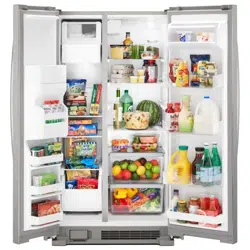Loading ...
Loading ...
Loading ...

35
WARNING: Connect only to the potable water supply.
Do not use with water that is microbiologically unsafe or
of unknown quality without adequate disinfection before
or after the system. Systems certified for cyst reduction
may be used on disinfected waters that may contain
filterable cysts.
IMPORTANT:
■ Plumbing installations should be executed in accordance with
the International plumbing code and local plumbing codes
and regulations.
■ The gray water pipe at the back of the refrigerator (used to
connect to the household water line) is a PEX (cross-linked
polyethylene) tubing. Copper and PEX connections from the
household water line to the refrigerator are acceptable and will
help to prevent the water and the ice from tasting or smelling
bad. Check for leaks.
■ Install tubing only in areas where temperatures will remain
above freezing.
TOOLS REQUIRED:
Gather the required tools and parts before starting the
installation.
■ Flat-blade screwdriver
■ 7/16" and 1/2" open-end wrenches or two adjustable
wrenches
■ 1/4" nut driver
Connection to the water line
IMPORTANT: If you turn on the refrigerator before connecting the
water line, turn off the ice maker.
Style 1 (Recommended)
1. Unplug the refrigerator or disconnect the power supply.
2. Turn off the main water supply. Turn on the nearest faucet long
enough to clear the water line.
3. Use a quarter-turn shutoff valve or equivalent supplied by a
1/2" (12.7 mm) household copper line.
NOTE: To allow sufcient water ow to the refrigerator, a
minimum 1/2" (12.7 mm) size copper household supply line is
recommended.
A
B
D
C
4. The copper tubing can now be connected to the shut-off
valve. Use soft copper tubing with a 1/4" (6.35 mm) outside
diameter to connect the shut-off valve and the refrigerator.
■ Make sure that it is long enough for the job in question.
Make sure that both ends of the copper tubing are cut to a
right angle.
■ Slide the compression sleeve and the compression nut
into the copper tubing as shown. Insert the end of the
tubing into the outlet end at a right angle as far as possible.
Screw the compression nut into the outlet end using the
adjustable nut driver. Do not overtighten.
B CA
5. Place the free end of the tubing into a container or sink, turn
on the main water supply and let the water run through the
tubing until the water comes out clean. Close the water pipe
shut-off valve.
NOTE: Always drain the water line before making the nal
connection to the inlet of the water valve to avoid possible
water valve malfunction.
6. Bend the copper tubing to meet the water line inlet, which
is located on the back of the refrigerator cabinet as shown.
Leave a coil of copper tubing to allow the refrigerator to be
pulled out of the cabinet or away from the wall for service.
Style 2
1. Unplug the refrigerator or disconnect the power supply.
2. Turn off the main water supply. Turn on the nearest faucet long
enough to clear the water line.
3. Locate a 1/2" (12.7 mm) to 1¼" (31.8 mm) vertical cold water
pipe near the refrigerator.
IMPORTANT:
■ Make sure that it is a cold water pipe.
■ A horizontal pipe will work, but drill on the top side of the
pipe, not the bottom. This will help to keep water away
from the drill and prevent normal sediment from collecting
in the valve.
4. To determine the length of copper tubing you are going to
need, measure from the connection on the lower left rear of
refrigerator to the water pipe. Add 7 ft (2.1 m) to allow for
cleaning. Use 1/4" (6.35 mm) outside diameter copper tubing.
Be sure both that ends of the copper tubing are cut straight.
5. Using a cordless drill, drill a 1/4" (6.35 mm) hole in the cold
water pipe you have selected.
A
B
C
DEF
G
6. Fasten the shutoff valve to the cold water pipe with a
pipe clamp. Make sure that the outlet end is solidly in the
1/4"(6.35mm) drilled hole in the water pipe and that the
washer is under the pipe clamp. Tighten the compression nut.
Tighten the pipe clamp screws slowly and evenly so that the
washer makes a watertight seal. Do not overtighten or you
may crush the copper tubing.
7. Slide the compression sleeve and the compression nut onto
the copper tubing as shown. Insert the end of the tubing
straight into the outlet end as far as possible. Screw the
compression nut into the outlet end using the adjustable nut
driver. Do not overtighten.
8. Place the free end of the tubing into a container or sink and
turn on the main water supply. Flush the tubing until the water
comes out clean. Turn off the shut-off valve on the water pipe.
Coil the copper tubing.
A. Cold water pipe
B. Pipe clamp
C. Copper tubing
D. Compression nut
E. Compression sleeve
F. Shut-off valve
G. Packing nut
A. Compression sleeve
B. Compression nut
C. Copper tubing
A. Bulb
B. Nut
C. Copper tubing (to the refrigerator)
D. Household supply line (1/2" [12.7 mm] at least)
Loading ...
Loading ...
Loading ...
